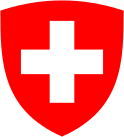Council of States (Switzerland)
| Council of States Ständerat (German) Conseil des États (French) Consiglio degli Stati (Italian) Cussegl dals Stadis (Romansh) | |
|---|---|
 | |
| Type | |
| Type | |
| Leadership | |
First Vice President | |
Second Vice President | |
| Structure | |
| Seats | 46 |
 | |
Political groups |
Government parties (43) Other parliamentary parties (3)
|
| Elections | |
Last election | 18 October 2015[1] |
| Meeting place | |
 | |
| Federal Palace of Switzerland, Bern | |
| Website | |
| http://www.parliament.ch/ | |
.svg.png) |
| This article is part of a series on the politics and government of Switzerland |
|
The Council of States (German: Ständerat, French: Conseil des États, Italian: Consiglio degli Stati, Romansh: Cussegl dals Stadis) is the smaller chamber of the Federal Assembly of Switzerland, and is considered the Assembly's upper house, with the National Council being the lower house. There are 46 Councillors.[2]
Twenty of the country's cantons are represented by two Councillors each. Six cantons, traditionally called "half cantons", are represented by one Councillor each for historical reasons. These are Obwalden, Nidwalden, Basel-Stadt, Basel-Landschaft, Appenzell Ausserrhoden and Appenzell Innerrhoden.[3]
The Councillors serve for four years, and are not bound in their vote to instructions from the cantonal authorities.
Elections
Under the Swiss Federal Constitution, the mode of election to the Council of States is left to the cantons, the proviso being that it must be a democratic method. All cantons now provide for the Councillors to be chosen by popular election (historically it was typically the cantons' parliaments that elected representatives to Bern), however those eligible to vote varies according to the applicable cantonal law (notable variances are that foreigners may vote in Neuchâtel, and the minimum voting age is 16 in Glarus).
In all cantons except for Appenzell Innerrhoden, the Councillors are elected concurrently with the members of the National Council. In the canton of Appenzell Innerrhoden the representative is elected by the physically convened popular assembly (Landsgemeinde) the April prior to the national vote.
With the exception of the cantons of Neuchâtel and Jura, where a proportional representation election system is used, the representatives are elected by majority vote in either one or two rounds of voting.[4]
Working languages
In debates, councilors can choose any of the federal languages, usually the one (s)he is most proficient with: German, French, Italian, or Romansh.[5] German (High German) and French are frequently used.
List of members
Seats by party
Summary of the 2015 Council of States of Switzerland results
| Parties | Ideology | 2011 | Seats | ± | |
|---|---|---|---|---|---|
| Christian Democratic People's Party (CVP/PDC) | Christian democracy | 13 | 13 | ±0 | |
| FDP.The Liberals (FDP/PRD) | Classical liberalism | 11 | 13 | +2 | |
| Social Democratic Party (SPS/PSS) | Social democracy | 11 | 12 | +1 | |
| Swiss People's Party (SVP/UDC) | National conservatism | 5 | 5 | ±0 | |
| Green Party (GPS/PES) | Green politics | 2 | 1 | -1 | |
| Green Liberal Party (GLP/PVL) | Green liberalism | 2 | 0 | -2 | |
| Conservative Democratic Party (BDP/PBD) | Conservatism / Economic liberalism | 1 | 1 | ±0 | |
| Independent | Independent | 1 | 1 | ±0 | |
| Total | 46 | 46 | |||
| Source: https://www.ch.ch/en/elections2015/resultate-staenderat/staenderat-a-z/ | |||||
Past seat compositions by party
2011 election
| Parties | Ideology | 2007 | Seats | ± | |
|---|---|---|---|---|---|
| Christian Democratic People's Party (CVP/PDC) | Christian democracy | 15 | 13 | -2 | |
| FDP.The Liberals (FDP/PRD) | Classical liberalism | 12 | 11 | -1 | |
| Social Democratic Party (SPS/PSS) | Social democracy | 9 | 11 | +2 | |
| Swiss People's Party (SVP/UDC) | National conservatism | 7 | 5 | -2 | |
| Green Party (GPS/PES) | Green politics | 2 | 2 | ±0 | |
| Green Liberal Party (GLP/VL) | Green liberalism | 1 | 2 | +1 | |
| Conservative Democratic Party (BDP/PBD) | Conservatism / Economic liberalism | New | 1 | +1 | |
| Independent | Independent | 0 | 1 | +1 | |
| Total | 46 | 46 | |||
| Source: http://www.politik-stat.ch/srw2011CH_de.html | |||||
2007 election
| Parties | Ideology | 2003 | Seats | ± | |
|---|---|---|---|---|---|
| Christian Democratic People's Party (CVP/PDC) | Christian democracy | 15 | 15 | ±0 | |
| Free Democratic Party (FDP/PRD) | Classical liberalism | 14 | 12 | –2 | |
| Social Democratic Party (SPS/PSS) | Social democracy | 9 | 9 | ±0 | |
| Swiss People's Party (SVP/UDC) | National conservatism | 8 | 7 | –1 | |
| Green Party (GPS/PES) | Green politics | 0 | 2 | +2 | |
| Green Liberal Party (GLP/VL) | Green liberalism | 0 | 1 | +1 | |
| Total | 46 | 46 | |||
| Source: http://www.politik-stat.ch/srw2007CH_de.html | |||||
Population per seat
The Council of States represents the federal nature of Switzerland: seats are distributed by state (canton), not by population. Most cantons send 2 representatives, while the historic half-cantons; Appenzell Ausserrhoden, Appenzell Innerrhoden, Obwalden, Nidwalden, Basel-Stadt and Basel-Landshaft, each send one.[3] Consequently, the number of people represented by a single seat in the Council of State varies by a factor of 40, from 15,000 for Appenzell Innerrhoden to 600,000 for Zurich.
| Abbr | Canton | Seats | Population ¹ | per seat | ² |
|---|---|---|---|---|---|
| ZH | Zurich | 2 | 1,466,100 | 733,050 | 1.0 |
| BE | Berne | 2 | 1,017,200 | 508,600 | 1.4 |
| VD | Vaud | 2 | 773,200 | 386,600 | 1.9 |
| AG | Aargau | 2 | 653,500 | 326,750 | 2.2 |
| BL | Basel-Country | 1 | 283,200 | 283,200 | 2.6 |
| SG | St. Gall | 2 | 499,000 | 249,500 | 2.9 |
| GE | Geneva | 2 | 484,400 | 242,200 | 3.0 |
| LU | Lucerne | 2 | 398,700 | 199,350 | 3.7 |
| BS | Basel-City | 1 | 191,800 | 191,800 | 3.8 |
| TI | Ticino | 2 | 351,900 | 175,950 | 4.2 |
| VS | Valais | 2 | 335,600 | 167,800 | 4.4 |
| FR | Fribourg | 2 | 307,400 | 153,700 | 4.8 |
| TG | Thurgau | 2 | 267,400 | 133,700 | 5.5 |
| SO | Solothurn | 2 | 266,400 | 133,200 | 5.5 |
| GR | Grisons | 2 | 196,600 | 98,300 | 7.5 |
| NE | Neuchâtel | 2 | 178,100 | 89,050 | 8.2 |
| SZ | Schwyz | 2 | 154,100 | 77,050 | 9.5 |
| ZG | Zug | 2 | 122,100 | 61,050 | 12.0 |
| AR | Appenzell Ausserrhoden | 1 | 54,500 | 54,500 | 13.5 |
| NW | Nidwalden | 1 | 42,400 | 42,400 | 17.3 |
| SH | Schaffhausen | 2 | 79,800 | 39,900 | 18.4 |
| OW | Obwalden | 1 | 37,100 | 37,100 | 19.8 |
| JU | Jura | 2 | 72,800 | 36,400 | 20.1 |
| GL | Glarus | 2 | 40,000 | 20,000 | 36.7 |
| UR | Uri | 2 | 36,000 | 18,000 | 40.7 |
| AI | Appenzell Innerrhoden | 1 | 16,000 | 16,000 | 45.8 |
| Overall | 46 | 8,325,200 | 180,983 | 4.1 | |
Notes: ¹ Population data from 2015 ([6]). ² Relative representation compared to Zürich.
Notes and references
Notes
- ↑ Part of the SVP/UDC parliamentary group
References
- 1 2 "Parliamentary Groups of the 50th Legislative Period 2015-2019" (official site). Berne, Switzerland: The Swiss Parliament. Retrieved 2016-08-09.
- ↑ "The Council of States" (official site). Berne, Switzerland: The Swiss Parliament. Retrieved 2016-08-09.
- 1 2 "Member of the Council of States by Canton" (official site). Berne, Switzerland: The Swiss Parliament. Retrieved 2016-08-09.
- ↑ "Elections 2015:How the elections to the Council of States are organised: process, rules and principal stages". ch.ch – A service of the Confederation, cantons and communes (official site). Berne, Switzerland: The Swiss Confederation. Retrieved 2016-08-09.
- ↑ "Art. 8 Bundesversammlung, SR 441.1 SpG (Bundesgesetz über die Landessprachen und die Verständigung zwischen den Sprachgemeinschaften)" (official site) (in German, French, Italian, and Romansh). Berne, Switzerland: The Swiss Federal Council. Retrieved 2016-08-09.
- ↑ Population data 2015 accessed 28 July 2016
See also
- List of members of the Swiss Council of States (2007-2011)
- List of members of the Swiss Council of States (2003-2007)
- List of Presidents of the Swiss Council of States
Bibliography
- The Swiss Confederation – A Brief Guide 2015 (PDF), Berne, Switzerland: Swiss Confederation, Swiss Federal Chancellery FCh of the Federal Chancellor Corina Casanova, 28 April 2015, retrieved 2016-01-04
External links
| Wikimedia Commons has media related to Federal Palace of Switzerland. |
- The Council of States
- The Swiss Parliament
- The Law Collection: SR 17 Bundesbehörden/Autorités fédérales/Autorità federali
